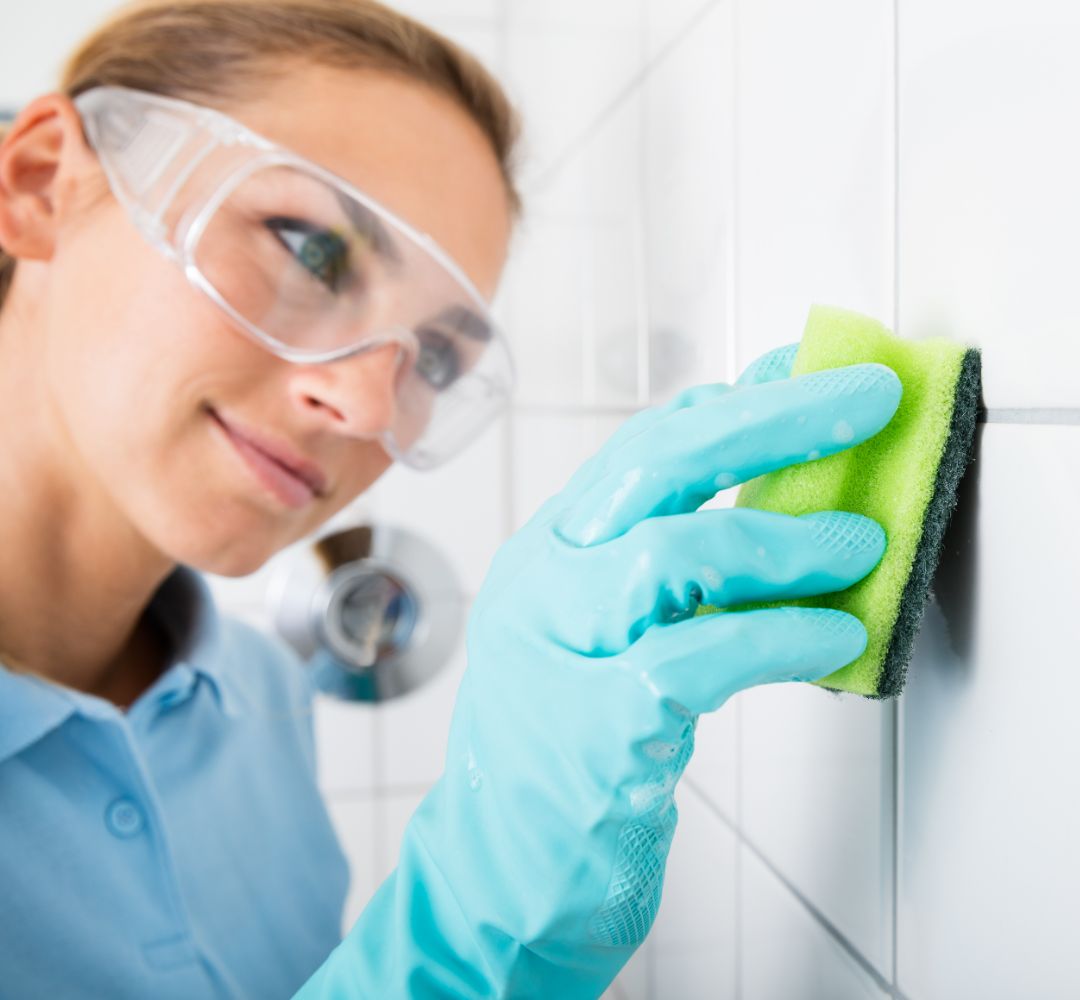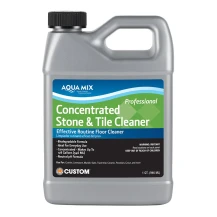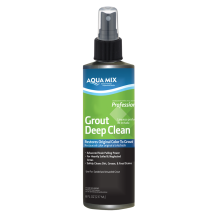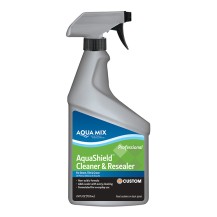Latest Updates in Cleaning & Maintenance
Best Practice: Cleaning IN/OUT Tiles
Our all-new IN/OUT ranges, for both internal and external areas, are manufactured using the latest glaze technology which contains micro crystalline particles. Since this is a revolutionary new glaze technology whereby the same matt surface tiles can be used for both internal and external wet and dry areas, we recommend that slightly differnet cleaning procedures be used to achieve the best effect.
Very often tiles appear difficult to clean after the job delivery because there can be grout haze residue remaining on the tile surface which was not completely removed after the grouting process. If such grout residue which is either cementitious or polymer based and is not thoroughly cleaned immediately after the grouting process, it will continue to attract
dirt and will create longer cleanability related problems. It is therefore of paramount importance that you ensure the tiling contractor or tiler completely removes all grout haze residue on the surface of tiles before handing over the project to you.
We recommend the following procedures for efficient and complete post installation cleaning:
(i) Sweep or vacuum all dirt and dust particles on the surface of tiles prior to commencing the grouting process.
(vi) If there are stubborn stains or grout haze residue remaining on the tile surface, apply tile cleaners or grout removers such as Aquamix Heavy Duty Tile & Grout Cleaner.
Follow grout manufacturers instructions and thereafter use a clean melamine sponge soaked with portable water to thoroughly clean the tiles. Never allow grout removers or cleaning detergents to dry up on the tile surface because it will form a thin film or glue-like layer which may end up sucking more dirt onto the tiled surface.
(viii) Do not use any cleaning products with high acid content to clean grout haze, especially cleaning detergents containing hydrofluoric acid and its derivatives because it may cause permanent damage to the tile surface.
(ix) If the situation permits, it is always best to use clean running water to completely flush out any grout haze residue remaining on the tile surface. If not, rinse the surface with clean portable water and mop-off all remaining water and residue. Repeat this process until all grout haze is completely removed.
(x) Once the IN/OUT tiles have gone through a thorough and complete grout haze cleaning process and there is no more grout haze residue on the tile surface, the below general or routine cleaning procedures should be performed on a regular basis.
(i) Vacuum or sweep all dusts, soil particles and dirt contaminants while the floor surface is still dry. As a general rule, all spills should be cleaned as quickly as possible and not allowed to dry. The longer you allow spills to dry on the tile surface, the more difficult it will be to remove those stains.
(ii) Use a wet mop with clean portable water for all general cleaning. Always keep changing the water because dirty water will result in transferring the dirt from one location to the other, rather than removing it.
(iii) Depending on the soil load, a more aggressive cleaning process may be required by using a neutral cleaner or a general house hold cleaner, than followed by thorough rinsing with water.
(iv) If there are difficult to remove contaminants or stubborn stains on the surface of tiles, firstly identify the specific spill or contaminants as different contaminants require different cleaning methods and cleaning solutions.
(v) Rince thoroughly with clean water to remove dirty detergent and emulsified soil. Rinsing is a critical step in the tile care & maintenance procedure.
(vi) Remove all residue and remaining water with a dry towel or by mopping.
NB: Tiles are always delivered in clean and new condition without any stains or grout haze residue on the tile surface. It is therefore the responsibility of the tiling contractor/tiler and not the tile distributor/manufacturer to ensure that the tiles remain clean and free from grout haze or contaminants after the tiling process.
Best Practice: General Tile Cleaning & Maintenance
Tiles are easy to clean and maintain, however, it is important that an effective cleaning regime is established for each area and type of surface texture of the tiles.
Cleaner and Safer Flooring - Matting is highly recommended at the entrance of a building or commercial area to stop dirt and moisture damage and for ease of maintenance.
GENERAL CLEANING
1. Sweep or vacuum to remove loose soil, sand or dirt contaminants.
2. Wash with clean water by mopping or scrubbing machine.
3. Depending on soil load, a more aggressive cleaning process may be required by using a neutral low sulphate cleaner then followed by a thorough rinsing.
DAILY MAINTENANCE
(i) For Unpolished, Matt and Honed Finished Tiles
1. Sweep or vacuum the floor of all loose dirt, sand and other foreign materials.
2. If there are difficult-to-remove contaminants on the surface of tile, firstly identify the specific spill or contaminant as different surface contaminants require different cleaning methods and chemicals.
3. Ensure detergent does not contain “hydrofluoric acid” or its compound, household bleaches, mosaic cleaner, etc. as they may attack the surface of tiles.
4. Please read and follow the manufacturer’s instructions and recommended usage.
5. Test cleaning in a small area first to see if etches the tiles or erodes the grout.
6. Do subdivide a large floor with few smaller sections to ease of the cleaning process.
7. If there is no issue with step 5, then to proceed cleaning a larger floor area by mopping or with the aid of scrubbing machine. Rinse the floor with clean and clear water and buff with a dry mop or using squeeze.
8. Replace the dirty cleaning solution and continue step no. 7.
9. It is important that all cleaner residues be completely removed from the tile surface. Any remaining residue that dry on the tile will form a coating which may trap dirt and be very difficult to clean later.
10.Rough textured tiles usually require a more regular cleaning maintenance and a little scrubbing may be needed.
11. For the difficult-to-remove contaminants, scrub the floor with nylon pad or bristle brush or affix the gentle scrubbing pad to the floor scrubbing machine for cleaning at a commercial area.
(ii) For Polished Tiles
1. Sweep or vacuum the floor of loose dirt.
2. Mop with a mild cleaning solution. Use 50% detergent concentrate than one would use on an unpolished floor.
3. Use damp mop with clean water for rinsing.
4. Dry thoroughly with a soft cloth or buffing pad to increase the shine and prevent water spots.
5. If cleaning is done with the aid of a scrubbing machine, please use melamine foam pad to prevent scratches on the tiles.
6. If there is stubborn dirt on the tiles, i.e. tyre mark at car showroom, try cleaning with a damp melamine foam pad.
(iii) For Wet Areas
1. Soap scum on walls can be cleaned with a damp melamine foam pad, e.g., magic sponge, magic eraser, Japanese sponge, wonder sponge, etc.
2. Flush or rinse with clean water.
3. Soap scum on floor can be minimised by using a squeegee after each use.
TIPS FOR SUCCESSFUL MAINTENANCE OF TILES
1. All spills should be cleaned as quickly as possible.
2. Use only recommended dilution of detergents.
Download our Cleaning & Maintenance Brochure here
If you would like to discuss your project further, we can assist.
Contact one of our 33 Stores or discuss with one of our Commercial Representatives.
Tile Warehouse - Making Design & Selection Easy - from the Floor up!








 1 Minute Read
1 Minute Read
 Jun 25
Jun 25











